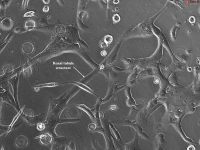Promotion of Duplex and Triplex DNA Formation by Polycation Comb-Type Copolymers
Triplex DNA has attracted considerable interest recently because of its possible biological functions in vivo and its wide variety of potential applications, such as regulation of gene expression, site-specific cleavage of duplex DNA, mapping of genomic DNA, and gene-targeted mutagenesis (1 –3) . A triplex is usually formed through the sequence-specific interaction of a single-stranded homopyrimidine or homopurine triplex-forming oligonucleotide (TFO) with the major groove of the homopurine-homopyrimidine stretch in duplex DNA (1 –5 ). In the pyrimidine motif triplex, a homopyrimidine TFO binds parallel to the homopurine strand of the target duplex by Hoogsteen hydrogen bonding to form T●A:T and C+● G:C triplets (● and : represent Hoogsteen hydrogen bonding and Watson Crick base pairing, respectively). (1 –5 ). Because the cytosine bases in a homopyrimidine TFO are to be protonated to bind with the guanine bases of the G:C duplex, the formation of the pyrimidine motif triplex needs an acidic pH condition, and is thus unstable at physiological pH (6 –8 ). On the other hand, in the purine motif triplex, a homopurine TFO binds antiparallel to the homopurine strand of the target duplex by reverse Hoogsteen hydrogen bonding to form A●A:T (or T●A:T) and G●G:C triplets (1 –5 ). Although the purine motif triplex is pH-independent, triplexes involving guanine-rich TFOs are inhibited by physiological concentrations of certain monovalent cations (M+) , especially K+ (9 ,10 )
![预览]()






